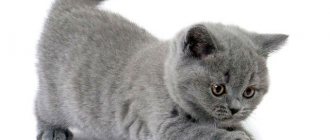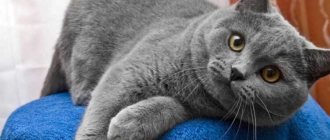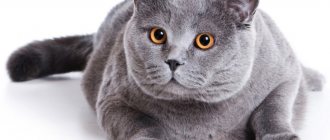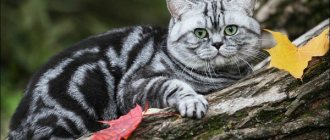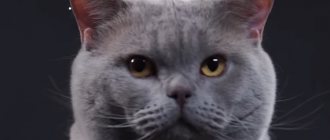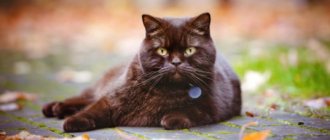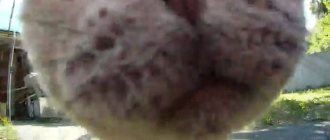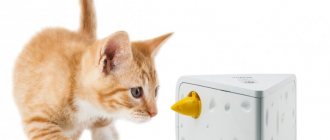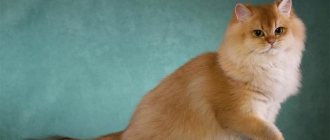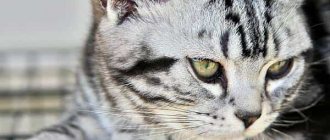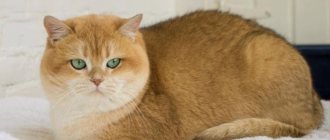It all starts at the embryonic stage of development. First, pigment cells appear, which are not yet able to produce color. They migrate to the hair follicles, take the form of an elongated capsule and are distributed along the length of the hair. The variety of colors in cats is the merit of only two melanins - red and black.
British cats of peach (cream) color belong to the group of red cats, in which parents passed on the genetic pheomelanin inheritance to their offspring. Let's find out how the coat color of cats is formed and whether there are differences in the character of animals with peach color.
Solid colors
The color should be solid and uniform, without variegated hairs, spots, shades or patterns.
The fur of such cats is short and thick, and soft to the touch, like plush.
There are 7 standard colors in total:
- Black
British black cat
- Light blue (gray, blue)
Blue British kitten
- Chocolate (brown)
Photo of a British chocolate cat
- Lilac (pink)
Lilac color of British cats
- Red (red, golden)
Photo of a red British cat
- Cream (peach, beige)
Photo of a cream British cat
- White
Photo of a white British cat
Eye color is bright copper or orange, and white British people can have blue or even multi-colored eyes.
White British kitten with blue eyes
Odd-eyed Briton
Colors cinnamon (cinnamon) and fawn
The very rare solid color cinnamon was developed quite recently.
It is much lighter than chocolate and is called the color of ground cinnamon.
Chocolate Britons have a nose color that is slightly darker than the coat or matches its color, while Cinnamon, on the contrary , has a pinkish-brown nose that stands out against the darker coat.
British cat cinnamon
Cats of the fawn (also called the color of a young fawn) have fur of a warm light beige shade, and the pads of their paws and nose are a delicate pinkish color.
The eye colors of cinnamons and fauns range from golden to rich copper.
British fawn cat
Description of the breed
The physiology and appearance of the British were formed under high humidity in cold climates, therefore this breed has dense short hair that protects from cold and moisture.
Since British cats are excellent hunters, they are strong, hardy and unpretentious in food.
The breed standard describes the British as follows:
- The head has a wide skull and is round. The cheeks are developed, the cheekbones are wide, the muzzle is flattened and round.
- The nose is wide, straight and short.
- The ears are rounded and small, set wide and low.
- The eyes are round, at a great distance from each other, which exceeds the width of the nose.
- The body is massive, with a developed chest and good muscles.
- The limbs are powerful, but short. Paws are rounded.
- The tail is thick.
- Weight - Males weigh 10-13 kg, and females from 6 to 9 kg.
Wool protects cats well from the cold due to the developed undercoat. It does not adhere to the body, is thick and plush to the touch.
Sometimes there are longhaired British cats. A recessive gene is responsible for long fur, so a long-haired kitten cannot appear from ordinary parents.
People often confuse British and Scottish cats: some even seriously think that there is such a breed - the British Fold. The two different breeds should not be confused.
Tortoiseshell colors
Spots of two colors are evenly distributed throughout the body.
This can be a combination of rich colors (black, chocolate or cinnamon) with red, as well as blue (or purple) with cream.
The colors are distributed equally and look harmonious. The thick coat is short and soft.
The paw pads are pink or black, and the eyes are copper and gold shades. Cream slippers on the paws or short stripes on the nose are possible.
The most common varieties:
- Chocolate cream
British Chocolate Cream Tortoise
- Blue-cream
British blue-cream tortoise
- Lilac-cream
British cat lilac-cream tortoiseshell
- Black tortoiseshell
Photo of a British black tortoiseshell cat
This color occurs only in female cats; due to the peculiarities of genetics, cats are not tortoiseshell.
Other photos of British tortoiseshell cats
#gallery-1 { margin: auto; } #gallery-1 .gallery-item { float: left; margin-top: 10px; text-align: center; width: 25%; } #gallery-1 img { border: 2px solid #cfcfcf; } #gallery-1 .gallery-caption { margin-left: 0; }
Personality of British Shorthair cats
| Activity |
| Playfulness |
| Sociability |
| Affectionateness |
| Friendliness |
| Intelligence |
British cats are independent and can easily tolerate loneliness. They don’t ask to be held, but they are not insensitive: the British love their owners with restraint, “in a gentlemanly manner.”
The British avoid strangers and prefer to first observe them from the sidelines. Such pets are unobtrusive, clean and smart. British cats do not use fangs and claws, so they are not dangerous for children.
Color point color
A characteristic feature of this group of colors is a light body color and contrasting dark areas - the muzzle, ears, paws and tail.
Color point colors can be solid, tortoiseshell, smoky, shaded, veiled.
The color with black spots is called seal point (Siamese color) .
British kitten black color point
There are also the following varieties:
- Red
British red color point cat
- Blue
Photo of blue british color point
- Lilac
British lilac color point
- Chocolate
Photo of a British kitten chocolate color point
- and Cream Points
The picture shows a British cat cream point
Each name refers to the color of the dark markings.
Colorpoints have blue or light blue eyes.
Funny nicknames
Finding a name for a small pet is a fun process that will engage everyone in the family.
Everyone wants a kitten to have a unique nickname that could convey all its external and internal qualities.
For this reason, you can resort to cool and funny names that will give the animal brightness and mystery.
Important! Among the cool names for animals you can find many strange and unusual ones.
A suitable option would be names starting with the letters m - Masyanya, Murzik, Mukha, Malina, Mashka, Mikha, Murzya, Migera.
Other nicknames may be suitable for cats:
The following cool names are suitable for cats:
Choosing a name for a kitten is a ceremony for many, especially if the pet is purebred and has a pedigree.
It is important to choose a nickname that conveys the character and external qualities of the animal.
Moreover, on the Internet there are beautiful, funny, cool, original and simple names for cats.
Useful video
You still don’t know what to name the kitten that just moved into your home? You can select several suitable options if you narrow your search area and choose exclusively from thematic areas that pique your interest. Then it will be necessary to discuss the versions with your family and settle on a nickname that is attractive to everyone.
What can you name a kitten?
Interesting and unusual names for kittens can be found in the literature. Think about your favorite or just colorful characters from books that are suitable to name a kitten. Interesting ideas can be found in both classic cinema and blockbusters. Comics and computer games provide great scope for imagination. You should focus on the breed; a luxurious cat can be called Churchill, and an elegant cat can be called Godiva. Try it, and you will understand that finding the answer to the question of what to name your kitten is not only simple, but also fun if you get involved:
- Trips.
- Gastronomy.
- Mythology.
- Cartoons.
- Fairy tales.
- Blockbusters.
- Other areas of your interests.
Names for boy kittens
You have just adopted a small male into your family, so this is a good choice, since cats have an easy-going character. When choosing what to name a boy kitten, look at the nicknames listed below:
Which nickname matches your pet can be understood intuitively. It is advisable to select names for boy kittens (Russian nicknames) with hissing notes, since furry cats love sounds similar to mouse rustling and remember them well. The nicknames Lusha, Yasha, Zhuzha are perfect. The nickname Syom Syomych sounds funny in relation to the baby. When the kitten grows up, the name will acquire a connotation of respectability.
Nicknames for girl kittens
As soon as you adopt a cat, you immediately want to choose a name from the list of lucky names for kittens in order to further protect the plush miracle. But you should wait a little so that the pet’s character becomes more obvious and then you can choose a nickname suitable for naming the kitten a girl. Check out the list first:
The question of how to choose a name for a girl kitten should also concern the animal’s guardian from the point of view of the speed of the pet’s assimilation of sounds. The female will respond best to Margosha or any other word with a hissing sound. The cat must understand that the name is hers, and not any of the household members or other animals. In this regard, the original word will be preferable.
Bicolor colors
The group includes combinations of white and other colors.
Also, two colors can be combined with white (tri-color color).
Bicolor colors are divided into 3 groups depending on the proportions of the colors.
- Van is an almost white animal, only the tail or spots on the head are colored.
British kitten blue van
British cat blue cream van
- Harlequin - white makes up approximately 4/5 of the surface of the body, and there are large colored markings on the back and head.
British cat black harlequin
British cat lilac harlequin
- Bicolor - about half of the body is painted white.
The picture shows a British cat chocolate-red bicolor
British bicolors must have white muzzle, collar, hips and paw pads.
British kitten blue bicolor
Their eyes are copper or golden in color.
Chinchilla
This species is considered the most expensive, as it is difficult to breed. At the same time, chinchillas are in great demand, which is determined by the depth of tone of the coat. As for shades, you can find the following individuals:
- Golden ones can boast of a rich apricot undercoat. But duller gray, silver is always defined as defective. The eyes must certainly be green, other variations are not allowed. At the same time, they certainly have eyeliner that matches the main palette of the animal.
- The silver chinchilla is more common than the previous one. However, even in this case there are strict requirements: for example, the undercoat must be white and the eyes must be green. The silver shade is especially rich on the sides, back and tail. If the breeder is inexperienced, he may breed individuals with spots. It is highly not recommended to allow such yellowish spots, since the cat will almost certainly be rejected in the future. This so-called “poor silver” is most often the result of an admixture of individuals with gold.
Nature was pleased to color British shorthair cats in more than 200 shades! These data are impressive and, of course, it is impossible to describe all possible variations in one article. However, it is definitely worth knowing about the most famous ones for beginning breeders.
Tabby colors
The peculiarity of representatives of tabby colors is patterns and drawings on the background of the main color, or on a silver/golden background.
Drawings are divided into 3 types :
- Marbled (or classic tabby) - clear patterns in the form of wide lines stand out on the body.
British cat chocolate marble
Dark stripes stretch along the back all the way to the tail, on the sides there are patterns in the form of curls, the tail and neck are decorated with rings. Colors of this type include marbled on gold and silver, as well as black marbled.
- Tiger Tabby (also known as Tabby or "Mackerel") - A longitudinal stripe runs along the line of the spine, from which thin stripes descend on the sides.
The picture shows a British black tiger tabby kitten
The tail is also striped, and the neck is covered with patterns that resemble necklaces.
- Spotted tabby - spots are located on the back and sides, they stand out against a light background. Their shape can be oblong, oval or round.
Photo of a British spotted tabby
Sometimes the tail is also spotted or decorated with open rings. The most common colors are brown-black, silver-black and brick red.
The silver tabby (also known as the Whiskey color) has a pale silver coat. A clear black pattern (marbled, spotted or brindle) is located on the body and limbs. The eyes are green or light hazel.
British cat black spots on silver
The brown tabby has a shiny copper-brown color as its main color. The type of pattern can be any : marble, brindle or spotted. On the body, black patterns are combined with stains or spots in shades of red.
British brown spot on a brown background
The main color of the blue tabby is ivory or blue with a dark blue pattern. In addition to drawings, the body
British blue brindle tabby
Red tabby cats have a clear pattern of rich red color set against a light golden background. Their eyes are copper or yellow.
In the photo there is a British red marbled kitten
Cream tabby cats have a pale cream base color. It has a contrasting pattern of beige or cream color, which is much darker than the main one.
Photo of a British cream tabby kitten
Story
The first mentions of this breed are found in ancient chronicles. There is no documented information about their origin. The first very large rat-catching cats were brought in by Roman centurions. Researchers suggest that cats were introduced by the Romans during an attack on the British Isles in 43 AD. e. In Britain they were called the “British cat”, in France - “Charteuse”, in Germany - “Carthusian cat”.
The animals were used as rodent hunters, but by the end of the 16th century, breeders paid attention to the appearance of cats. The British attended the first London cat show in 1871. Then official breed standards were adopted, and felinology began its rapid development.
The first British appeared in Russia in 1992, along with the Cartheusers, who are now called in Russia “the old type of British.”
To consolidate the unique features of the British, breeders used Persian cats - which is why British cats have a slightly flat face.
What to feed your British Fold
Before purchasing a fold-eared kitten, you should decide on the method of feeding it. This should be either constant natural nutrition or feeding with ready-made food.
Important! It is not recommended to feed a British cat a mixed diet - this can lead to stomach upsets and more serious illnesses.
The British cat breed prefers meat based on natural products (scraped beef or lamb, raw turkey, boiled or baked chicken). It should be noted that it is strictly forbidden to give too fatty meat (goose and duck) to a lop-eared Briton!
Good occasional meat substitutes include whole milk and low-fat cottage cheese. You can give yogurt, kefir and cheese in moderation. The British Fold cat's additional food should be a variety of cereals and vegetables.
Don't forget that natural products also require vitamin supplements, which can be found in any specialty store. Kittens under 1 month of age are allowed to choose special vitamin and mineral preparations, which should be used only strictly according to the instructions.
If you prefer ready-made food, try to choose one of the premium or super-premium professional foods. Cheap food can cause irreparable harm to your pet's health.
Provide constant access to water. It is better if it is filtered or purchased drinking water.
